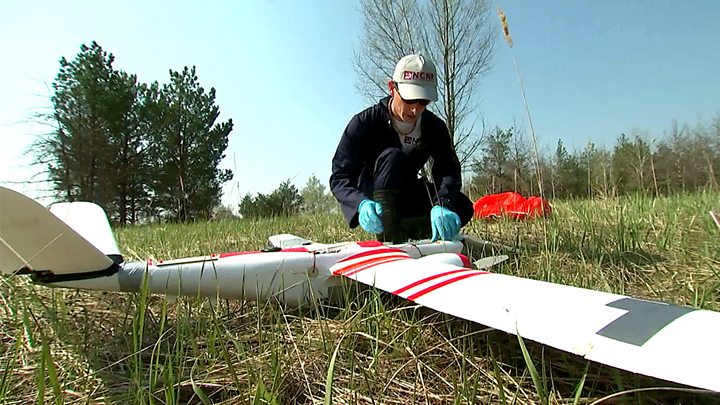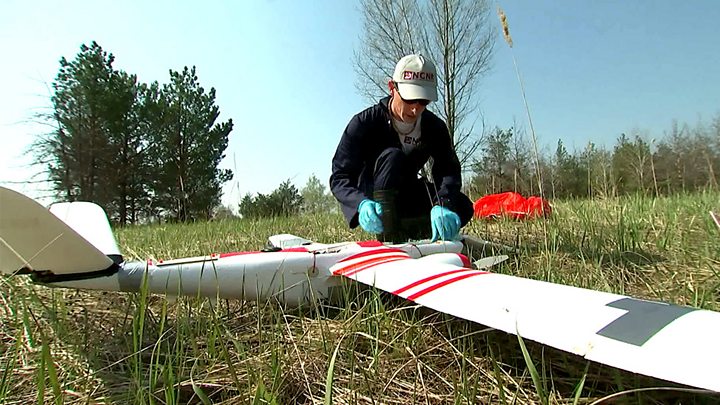UK drones map Chernobyl’s ‘Red Forest’


Media playback is unsupported on your device
Chernobyl’s “Red Forest” – one of the most radioactive locations on Earth – has just been surveyed by UK scientists using a suite of drones.
The robotic aircraft flew novel sensors that have given Ukrainian authorities more up-to-date information on the sites with the greatest contamination.
The Red Forest is just 500m from the Chernobyl nuclear complex.
It was hit by the immediate fallout from the 1986 explosion and fire in the plant’s number-4 reactor.
Many of the forest’s trees died and turned orange. Some areas are still strictly out of bounds to humans.
The UK’s National Centre for Nuclear Robotics (NCNR) has developed a drone-mapping system that allows scientists to investigate hazardous places from a safe distance.
Fixed-wing craft are first used to make a general radiation map by flying at about 40mph (65km/h) just above the treetops, in a grid pattern.
Places of interest are then followed up with rotary-wing drones.
These can hover and use their sensors to acquire high-resolution, 3D information.
The survey conducted in April essentially confirmed the current understanding of the radiation distribution in the forest, but in far greater detail than has previously been available.
The drones also identified a few unexpected hotspots.
One of these, a few km to the south of the forest, turned out to be an old soil separation unit used during the original clean-up efforts.
“They were trying to separate out the contamination and thereby reduce the volume of the waste,” Prof Tom Scott, from Bristol University and co-director of the NCNR, told BBC News.
“The legacy left at that facility is essentially spent nuclear fuel scattered on the floor, which was giving a very high radiation dose. About 1.2 millisieverts an hour. That would mean I’d be able to hit my yearly dose within just a few hours.”
The NCNR team plans to go back to Ukraine in the coming months to survey additional areas in Chernobyl’s 2,600km² Exclusion Zone, which is permitting more and more people to enter over time.
Some 70,000 tourists even visited the zone last year and there are plans to use large areas of land deemed now to be low risk for solar generation.
The British mapping exercise will help refine the protocols used to ensure the safety of all entrants to the exclusion zone.
The NCNR is a nationwide consortium of research experts tasked with developing the next generation of technologies that can be used to clean up Britain’s 4.9-million tonnes of legacy nuclear waste.
Specialists in robotics, artificial intelligence (AI)/machine learning, sensors, electronics and materials are working across eight institutes, centred on a hub at the University of Birmingham.
One key goal is to come up with autonomous robots that can efficiently and safely curate the waste.
These tools are far more advanced than the systems people will know from car assembly lines, said Prof Rustam Stolkin from the University of Birmingham.
“These robots are completely autonomous; they’re driven by a hundred thousand lines of AI code,” he explained.
“They use robotic vision systems; they see objects and understand their position, their size and their shape; and plan where to put fingers to achieve a stable grasp.
“They can clear a random, cluttered heap of objects with no prior knowledge of those objects. This is the frontier of international robotics and AI research.”
It’s hoped many of the NCNR’s technologies will have export and spin-out potential. The drone system is already being tested for mineral prospecting.
“The drones fly at a height which means they’re much more sensitive than if you fly in a helicopter or an aeroplane,” said Prof Scott.
“Some of the minerals we’d be interested in are gold and rare earth elements and cobalt. These are some of the most valuable materials we can think of and as minerals, they all have characteristic radioactive anomalies.”
Jonathan.Amos-INTERNET@bbc.co.uk and follow me on Twitter: @BBCAmos


